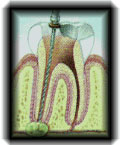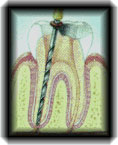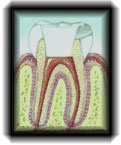 CELEBRATING **25** YEARS OF DENTAL EXCELLENCE | | ISO 9001:2000 CERTIFIED |
A2 AASHIRWAD, II CROSS LANE, LOKHANDWALA COMPLEX, ANDHERI (WEST), MUMBAI 400053, INDIA | 2632 8682 / 3082 7053 / 98193 63215 |
 CELEBRATING **25** YEARS OF DENTAL EXCELLENCE | | ISO 9001:2000 CERTIFIED |
A2 AASHIRWAD, II CROSS LANE, LOKHANDWALA COMPLEX, ANDHERI (WEST), MUMBAI 400053, INDIA | 2632 8682 / 3082 7053 / 98193 63215 |
| Antibiotics | Baby Teeth | Bad Breath | Bleaching | Bonding | Brushing | Bruxism | Caries (Decay) | Cosmetic Dentistry | Crowns & Bridges | Dentures | Dry Mouth | Emergencies | Endodontics | Extraction | Flossing | Gum Disease | Implants | Migraine | NTI | Oral Cancer | Orthodontia | Pregnancy | Preventive | Sealants | Silver fillings | Tobacco | Toothpastes | Veneers | Wisdom Teeth | XRays |
|
ENDODONTICS (ROOT CANAL THERAPY) |
|
THE TOOTH & IT'S SURROUNDING TISSUES |
|
CROWN- this is the part of the tooth you can see above the gumline. ROOT - this part of the tooth sits in the bone below the gum. The root of your tooth is usually twice as long as the crown, the part you see above the gumline. BONE- the roots of your teeth are anchored by bone.Healthy teeth stimulate and keep bone tissue healthy. PERIODONTAL LIGAMENT - like the springs that hold a trampoline to its frame, this tissue supports the tooth and holds it in place in the bony socket surrounding the tooth.This tissue cushions both the tooth and the surrounding bone against the shock of chewing and biting. GUM - dentists call this the "gingiva." It covers the bone surrounding your teeth. When you brush your teeth after meals and floss daily, you keep this tissue healthy. That's important, because gum disease can cause bone loss. Gum disease can also expose the tooth roots to decay. If root decay affects the pulp, you may need root canal treatment |
|
THE STORY OF ROOT CANAL THERAPY |
|
Molar RCF animation |
|
Premolar RCF Xray animation |
|
The tooth is not a solid object, but rather has a space in its center. Each tooth has a soft tissue (the pulp) in this space. This tissue partially nourishes the tooth from the inside. Because of deep decay, injury, or gum disease, the tissue in your tooth has become inflammed or infected (diseased). In any other part of your body, if a similar tissue becomes diseased, the body merely throws it off and forms new tissue. However, a tooth is a uniqueand different situation. Because the soft tissue within the tooth is totally encased within hard tissue, the body cannot get to it in order to affect repair. Therefore, it is the role of the dentist to do what the body is unable to do. He must remove the soft tissue located in the internal spaces(canals), cleanse the area, and finally fill the canals with a special material so that bacteria cannot re-enter the tooth to cause another infection. When the endodontic treatment is complete, the tooth is by no means "dead". It receives quite adequate support from the surrounding tissues and may be expected to last as long as any other natural tooth. |

| STEP 1
After the tooth is anesthetized, an opening |

| STEP 2
The length of the root canals is determined |

| STEP 3
Unhealthy pulp is removed. Canals are |

| STEP 4
Canals are filled and sealed. A metal post may be
added for structural support or to retain |

| STEP 5
The tooth is sealed with a temporary filling.
|
|
FREQUENTLY ASKED QUESTIONS ABOUT ROOT CANAL THERAPY |
|
Nothing is as good as a natural tooth! And sometimes your natural tooth may need endodontic (root canal) treatment for it to remain a healthy part of your mouth.Most patients report that having endodontic (root canal) treatment today is as unremarkable as having a cavity filled. If you've been told you need endodontic (root canal)treatment, you can find the answers to your questions below. Who performs endodontic treatment? All dentists, including your general dentist, received training in endodontics while in dental school.
Why is there a need for endodontic treatment? Sometimes the pulp inside your tooth becomes inflamed or
infected. This can be caused by deep decay, repeated dental
procedures on the tooth, a crack or chip in the tooth, or a blow
to the tooth.
What are the signs of needing endodontic treatment? Signs to look for include pain, prolonged sensitivity to heat or cold, discoloration of the tooth, and swelling and tenderness in the nearby gums. But sometimes, there are no symptoms.
How does endodontic treatment save the tooth? The dentist removes the inflamed or infected pulp, carefully cleans and shapes the inside of the tooth, then fills
and seals the space. Afterwards,he will place a crown or other
restoration on the tooth to protect it and restore it to full function.
Will I feel pain during or after the procedure? While many patients may be in great pain before seeing the
dentist, most report that the pain is relieved by the dentist and that they are comfortable during the procedure. For the first few days after treatment, the tooth may feel sensitive, especially if there was pain or infection before the procedure. This discomfort can be relieved with medications. The dentist will tell you how to care for your tooth at home.
Will the tooth need any special care or additional treatment? You should not chew or bite on the treated tooth until you have had it restored by your dentist, because it could fracture. Otherwise, just practice good oral hygiene - brushing,
flossing and regular checkups and cleanings. Endodontically treated teeth can last for many years, even a lifetime.
What causes an endodontically treated tooth to need additional treatment? New trauma, deep decay, or a loose, cracked or broken filling
can cause new infection in your tooth. In some cases, your
dentist may discover very narrow or curved canals that could not be treated during the initial procedure. |
|
RELATED NEWS ITEMS |
| Antibiotics | Baby Teeth | Bad Breath | Bleaching | Bonding | Brushing | Bruxism | Caries (Decay) | Cosmetic Dentistry | Crowns & Bridges | Dentures | Dry Mouth | Emergencies | Endodontics | Extraction | Flossing | Gum Disease | Implants | Migraine | NTI | Oral Cancer | Orthodontia | Pregnancy | Preventive | Sealants | Silver fillings | Tobacco | Toothpastes | Veneers | Wisdom Teeth | XRays | Dental Tourism |